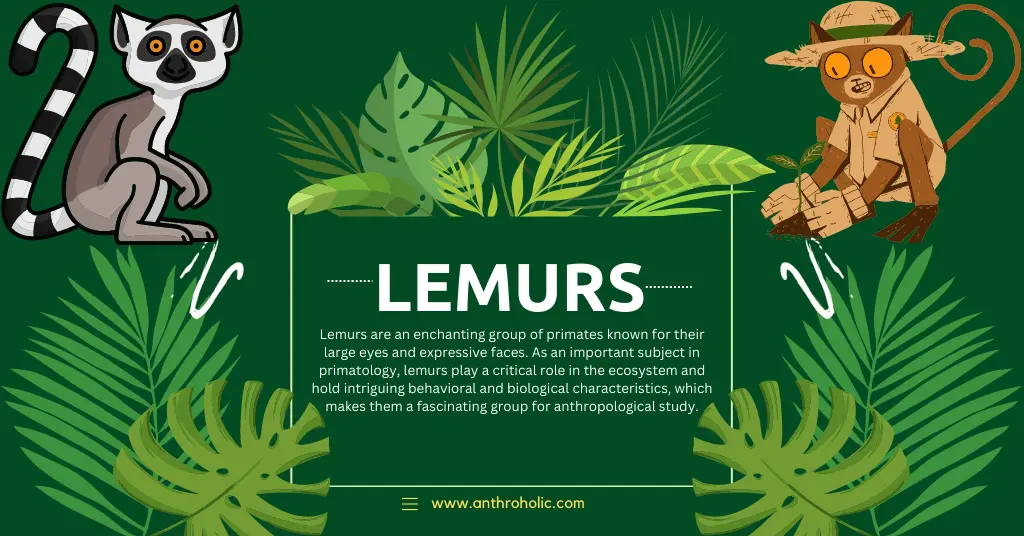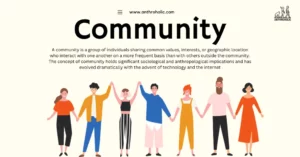AI Answer Evaluation Platform Live Now. Try Free Answer Evaluation Now
Lemurs
Lemurs are an enchanting group of primates known for their large eyes and expressive faces. As an important subject in primatology, lemurs play a critical role in the ecosystem and hold intriguing behavioral and biological characteristics, which makes them a fascinating group for anthropological study.

Classification and Distribution
Lemurs belong to the biological infraorder ‘Lemuriformes’ and are exclusive to the island of Madagascar and the nearby Comoro Islands [1]. This geographic isolation has resulted in a diverse range of species, with almost 100 known species to date [2]. The table below provides a snapshot of some prominent lemur families and a few representative species:
| Family | Example Species |
|---|---|
| Cheirogaleidae | Mouse Lemur |
| Indriidae | Indri |
| Lemuridae | Ring-Tailed Lemur |
| Lepilemuridae | Sportive Lemur |
| Daubentoniidae | Aye-Aye |
Physical Characteristics
Lemurs come in a variety of sizes, from the tiny mouse lemur at about 30 grams to the indri lemur that can weigh up to 9.5 kg [3]. Apart from the size variation, lemurs are recognized by their:
- Long, furry tails that can often exceed their body length
- Two-layered coat of fur, usually colored brown or grey
- Large, round eyes promoting excellent night vision
Behavioral Traits
Social Structure
Most lemur species exhibit social behavior, living in organized groups known as ‘troops’. However, the social structure can vary among species. Some live in female-dominated societies, such as the ring-tailed lemurs, while others like the indri live in monogamous pairs [4].
Communication
Lemurs possess a sophisticated range of vocal and non-vocal communication methods. Vocalizations range from warning calls to mating songs, while non-vocal communication includes scent marking and visual signals.
Conservation Status
Lemurs are considered among the world’s most endangered mammals [5]. Deforestation, hunting, and climate change have put immense pressure on their populations.
Conservation Efforts
Several initiatives are being undertaken to protect lemurs, including:
- Protected reserves: National parks and reserves in Madagascar are working towards preserving lemur habitats.
- Breeding programs: Captive breeding programs ensure the survival of endangered species.
- Education: Local and global education programs aim at increasing awareness about the importance of lemurs and their conservation.
Dietary Habits
Lemurs are omnivores, with dietary habits that vary significantly across species. While many primarily feed on fruits, leaves, and insects, some have more specialized diets:
- The Aye-aye uses its elongated middle finger to extract insect larvae from tree bark [6].
- The Indri is folivorous, consuming a wide variety of leaves [7].
Reproductive Behavior
Lemurs have a seasonal reproductive pattern, typically mating once a year. Ring-tailed lemurs, for instance, have a ‘mating season’ that lasts for a couple of weeks [8]. Gestation periods vary but can last up to six months, and most lemurs usually give birth to a single offspring at a time [9].
Lemurs in Culture and Folklore
Madagascar’s indigenous cultures have diverse beliefs and attitudes towards lemurs. Some tribes revere them as ancestral spirits, while others consider certain species as harbingers of bad luck [10]. These attitudes often shape local interactions with lemur populations.
The Future of Lemurs
Despite being endangered, lemurs possess the resilience to bounce back if given the right conditions. Concerted global efforts are required to preserve and restore their natural habitats. Additionally, promoting ecotourism can provide an alternative income for local communities, thus reducing pressures of hunting and habitat encroachment.
Understanding and respecting the local cultural attitudes towards lemurs can also significantly contribute to their conservation.
Importance in Anthropology
As primates, lemurs are integral to the study of primatology. Their unique evolutionary path, isolated on the island of Madagascar, provides key insights into primate adaptation and evolution. Furthermore, their intricate social behaviors serve as a model to understand the social structures of early humans.
Conclusion
Lemurs, while being enchanting creatures, are also critical to our understanding of primatology. Their fascinating behaviors, biological traits, and unique evolutionary history make them a captivating area of study. However, their endangered status necessitates immediate and effective conservation efforts.
References
[1] Mittermeier, R. A., Louis, E. E., Richardson, M., Schwitzer, C., Langrand, O., Rylands, A. B., … & Rajaobelina, S. (2010). Lemurs of Madagascar. Conservation International. https://www.researchgate.net/publication/259803435_Review_of_Lemurs_of_Madagascar
[2] Tattersall, I. (2013). Madagascar’s lemurs: Cryptic diversity or taxonomic inflation?. Evolutionary Anthropology: Issues, News, and Reviews, 22(3), 106-113. http://dx.doi.org/10.1002/evan.20126
[3] Smith, R. J., & Jungers, W. L. (1997). Body mass in comparative primatology. Journal of Human Evolution, 32(6), 523-559.
[4] Sauther, M. L., Sussman, R. W., & Gould, L. (1999). The socioecology of the ringtailed lemur: Thirty-five years of research. Evolutionary Anthropology: Issues, News, and Reviews: Issues, News, and Reviews, 8(4), 120-132.
[5] Schwitzer, C., Mittermeier, R. A., Johnson, S. E., Donati, G., Irwin, M., Peacock, H., … & Wright, P. C. (2014). Averting lemur extinctions amid Madagascar’s political crisis. Science, 343(6173), 842-843.
[6] Erickson, C. J., Nowicki, S., Dollar, L., & Goehring, N. (1998). Percussive foraging: Stimulating termite nests during the aye-ayes’ diurnal resting phase. Lemur Social Systems and Their Ecological Basis, 21, 45-56.
[7] Pollock, J. I. (1975). Field observations on Indri indri: a preliminary report. In Lemur biology (pp. 499-519). Springer, New York, NY.
[8] Jolly, A. (1966). Lemur behavior: a Madagascar field study. University of Chicago Press.
[9] Kappeler, P. M. (1997). Intrasexual selection in Mirza coquereli: evidence for scramble competition polygyny in a solitary primate. Behavioral Ecology and Sociobiology, 41(2), 77-85.
[10] Golden, C. D. (2009). Bushmeat hunting and use in the Makira Forest, north-eastern Madagascar: a conservation and livelihoods issue. Oryx, 43(3), 386-392.




